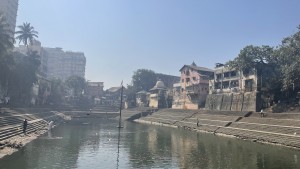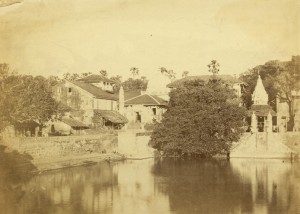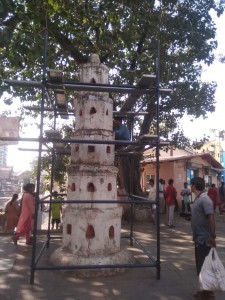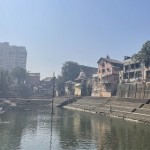In early 2023, the Gaud Saraswat Brahmin (GSB) Temple Trust and the Maharashtra State Archaeology department submitted detailed plans for restoring, cleaning, and revamping the ancient Banganga Tank in South Mumbai’s Walkeshwar precinct. The GSB Trust, formed in 1879 as a cultural association for the city’s growing population of Saraswat Brahmins[1], owns and manages the tank and the nearby Walkeshwar Temple along with 11 other temples in the complex.
For the island of Bombay or Mumbaaiee (named after the island’s patron goddess Mumbadevi), the Banganga Tank and its temple are evidence of the city’s roots in Hindu mythology, most particularly the Ramayana, and its medieval past. This is often overlooked given the city’s dominant position during the British Raj, reflected in the abundant colonial-era buildings of the metropolis.
The tank was first classified as a protected heritage site by the Maharashtra state archaeology department in 1989 and the Mumbai Metropolitan Region’s Heritage Conservation Society in 1995 respectively. A Banganga Conservation Committee[2] was formed by the city government[3] and Walkeshwar’s ward office to make the tank people-friendly, level the streets around it and keep the ghat[4] clean. However, the tank and its surroundings have fallen into disrepair through neglect, despite some attempts by private citizens, private temple trusts, conservationists, and the government to preserve and restore it.[5] Most of these initiatives were piecemeal, only repairing certain parts of the tank or a few temples at a time. Finally in 2022, the GSB Trust stepped forward to conserve the site holistically with a serious plan conceived by conservation architect Vikas Dilawari.[6]

(courtesy: Charuta Ghadyalpatil)
The Tank deserves this attention. The Malabar hill on which the tank is located lies along the path of the most important places of ancient Hindu, Buddhist, and Jain worship in western India. Early maps of Bombay’s seven islands show the Walkeshwar temple, the Shaivite and Buddhist Elephanta caves and the Buddhist Kanheri caves along with older Hindu shrines in present-day Mahalakshmi, Mahim and Prabhadevi. Walkeshwar was likely a Koli hamlet. The Kolis are Bombay’s original inhabitants and occupied its oldest sites of human settlement.[7] Given its location on the largest island among Bombay’s original seven, the tank offers a point of entry into the city’s history that pushes back its origin by at least six hundred years to the 12th century.
A combination of mythology and oral tradition traces the tank’s origins back to the Ramayana. Legend says Lord Rama and his brother Lakshmana stopped at Walkeshwar on their way to Lanka where they planned to rescue Lord Rama’s wife Sita imprisoned by the King of Lanka. Unable to find fresh water in the vicinity, Rama first built a Shiv lingam out of sand to pray to Lord Shiva for his blessings for a successful outcome. The spot where he prayed is sanctified by the medieval Walkeshwar (lit. Valuka or sand, and Ishwar or God) temple. Rama then launched an arrow into the ground that breached the netherworld (Pataal) and released the river Bhagwati, a tributary of the holy Ganga that is believed to be flowing underground. Bhagwati burst forth as a spring with the waters of the Ganga. The tank derives its name from here: Ban for the arrow and Ganga for the river. A pole in the middle of the tank marks the spot where Rama’s arrow is believed to have struck the earth.[8].[9]

(source: British Library)
Archaeological evidence dates Banganga and the Walkeshwar Shiva Temple, to the 12th and 13th centuries. Both were built during the Silhara dynasty, whose kings also built the Shiva Temple in Ambernath around the same time. During this time, the village of Walkeshwar was inhabited by a diversity of indigenous communities, fisherfolk, and a floating population of pilgrims and holy men.[10] The Portuguese, who arrived in the Bombay archipelago in the 16th century, regularly raided and desecrated sites of worship like the Walkeshwar Temple. As a result, much of the village’s indigenous population moved away, and the tank and the temples fell into disrepair during Portuguese rule. It was with the island’s English occupation that native communities gradually moved back to the site and leading Hindu merchants helped in its repairs and expansion.[11] [12] By the 1860s, there were nearly 20 temples around the tank and as many as 50 dharamsalas or boarding houses in the complex. Visiting pilgrims stayed at these dharamshalas, which were typically attached to private homes of the devout in the village.[13]
These efforts have meant that Banganga has remained a site of continuous and active religious and cultural use. According to Rutvik Aurangabadkar, chief of projects at the GSB Trust which is undertaking the restoration, Banganga is Mumbai’s Kashi and there is an urgency to take up the Banganga Teerthakshetra Corridor project also proposed by GSB Trust.[14] This corridor will enable the trust to coordinate its activities with the Maharashtra state government to preserve the Banganga heritage precinct as a site of religious significance at an institutional level.
It will not be easy. Modernity has overtaken the hill. A major challenge to maintaining the integrity of the Tank and its temples has been construction debris from the many high-rise residential buildings which have replaced the low-slung bungalows and gardens that filled the hill in the 19th century.[15] Construction debris is particularly reprehensible, responsible for choking the water source of the tank and its dipping water levels.
The GSB Trust is forging ahead, nevertheless. It plans:
1. A thorough desilting and cleaning of the tank and its entry points, blocked by continuous construction of high rises since the 1960s and 1970s.
2. Restoring the 12 Trust-owned temples individually by adding concrete and steel reinforcements to the structures.
3. The 11 stone deep-stambhs (columns built in temple complexes and lit with oil lamps to mark special occasions) erected around the tank are being replastered and reinforced using limestone, and other natural materials.
4. Clearing the area around the tank property of encroachments by working with the Maharashtra state government. Small shops, slum dwellings, and unlicensed hawkers have crowded the neighbourhood’s narrow by-lanes, blocking most of the entrances to the tank and its access to the sea and the main road.

(courtesy: Rutvik Aurangabadkar)
This will help the Trust in the cultural revival of the famous and popular annual Banganga Festival, not held at the tank since 2008,[16] and restore the religious Maha-aarti to its monthly full-moon calendar.[17]
This is good news for Mumbai and the tank’s continued presence in the sacred geography of western India. The GSB restoration runs parallel with a plan by the Maharashtra government to develop this precinct as a significant tourist site. Their successful completion offers a blueprint for incorporating similar precolonial heritage sites within India’s contemporary cityscape.
Charuta Ghadyalpatil is a Research Assistant, Gateway House.
This article was exclusively written for Gateway House: Indian Council on Global Relations. You can read more exclusive content here
For permission to republish, please contact outreach@gatewayhouse.in
©Copyright 2023 Gateway House: Indian Council on Global Relations. All rights reserved. Any unauthorised copying or reproduction is strictly prohibited.
References
[1] The community was dispersed along the west coast of India, especially in the Konkan region of present-day Maharashtra. Saraswat Brahmins were active in the Indian ocean trade in the early modern period (14th-17th centuries) and started settling in and around Bombay around the early 1700s.
[2] The Committee was formed under the chairmanship of the Municipal Commissioner and worked alongside the Heritage Advisory Committee of the Bombay Municipal Corporation.
[3] Bombay was renamed as Mumbai in 1995. The following year, the Bombay Municipal Corporation also changed its name to Municipal Corporation of Greater Mumbai.
[4] In this context, a ghat is a reference to a path of descent, normally steps, leading to the banks of a river or a water tank. Similar steps line the riverfront at other holy sites like Varanasi and Haridwar. They provide worshippers access to the holy waters and act as sites for the performance of prayers and ritual bathing.
[5] In 1989, the neighbourhood’s residents got together to clean the tank, remove the silt, and rebuild the dislodged steps of the ghat. See Bhatia Harshad, ‘Banganga: The ‘Whole’ as a ‘Part’ in Metropolitan Mumbai’, Journal of Architectural Conservation, Vol 7, No. 1, 84. (2001).
[6] The details of the restoration project were revealed to the author by Rutvik Aurangabadkar, CEO (Projects) at the GSB Trust office. The project is headed by Shashi Prabhu & Associates in consultation with conservation architect Vikas Dilawari.
[7] “Village of Walkeshwar, Malabar Point, Bombay,” Asia, Pacific, and Africa Collections, British Library Online Galleries, https://www.bl.uk/onlinegallery/onlineex/apac/photocoll/v/019pho000000937u00009000.html.
[8] “Tank in Walkeshwar, Bombay,” Asia, Pacific, and Africa Collections, British Library Online Galleries, https://www.bl.uk/onlinegallery/onlineex/apac/photocoll/t/019pho0000254s3u00016000.html.
[9] “The Walkeshwar Temple,” TIFR: Mumbai/Bombay Pages, https://theory.tifr.res.in/bombay/architecture/building/walkeshwar.html.
[10] Murali Ranganathan (trans.), Govind Narayan’s Mumbai: An Urban Biography from 1863 (New York: Anthem Press, 2008), p 62.
[11] “Village of Walkeshwar, Malabar Point, Bombay,” Asia, Pacific, and Africa Collections, British Library Online Galleries, https://www.bl.uk/onlinegallery/onlineex/apac/photocoll/v/019pho000000937u00009000.html.
[12] Over the coming years, Bombay’s merchants played a stellar role in repairing much of the tank and building additional temples around it. For instance, Rama Kamath, a merchant businessman, funded much of the tank’s rebuilding in 1715. Kamath belonged to the Shenvi or the Gaud Saraswat Brahmin community. This trading community had settled along in and around Bombay and parts of the western coast by the 18th century. The city government pitched in too, hiring over 300 labourers in 1832 to desilt the tank. See Murali Ranganathan (trans.), Govind Narayan’s Mumbai: An Urban Biography from 1863 (New York: Anthem Press, 2008), 79.
[13] “Malabar Hill & Breach Candy,” TIFR: Mumbai/Bombay pages, https://theory.tifr.res.in/bombay/physical/geo/malabar-hill.html
[14] For the last 30 years, Banganga’s popularity has grown in the city, through the organisation of music and dance festivals. In 1992, the Indian Heritage Society’s Mumbai chapter along with the Maharashtra Tourism Development Corporation (MTDC) introduced a music concert, the Banganga Festival, held annually every January. Separately, since 2014, the GSB Trust has independently conducted a Maha-aarti (a prayer in which lighted lamps are offered to the gods as part of puja ritual) are lit to mark the Diwali festival.
[15] The city’s English residents were drawn to Malabar Hill because of its idyllic isolation from the rest of the city. Government officials and Bombay’s governors built bungalows along the hillside and regularly retreated to Walkeshwar’s cool environment during the summer.
[16] The Festival was moved to the steps of the Asiatic Society in 2009 after concerns over noise pollution in the Banganga precinct were raised by the residents and a Bombay High Court order made restrictions over noise and the enforcement of silent zones stricter.
[17] The details of the restoration were outlined by Mr Aurangabadkar in a conversation with the author.


